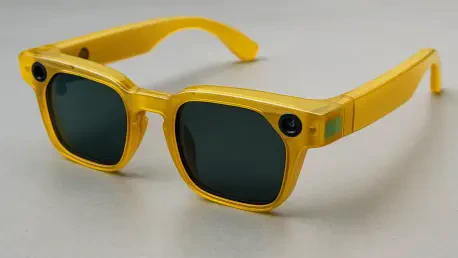Imagine a world where augmented reality (AR) seamlessly blends with everyday life, transforming how people interact with information, entertainment, and each other through lightweight, stylish glasses. This vision drives Snap, the company behind Snapchat, as it embarks on an ambitious journey to introduce a groundbreaking standalone AR device by next year. With a decade of innovation in smart glasses under its belt, Snap is now navigating financial challenges to bring its latest project, dubbed Specs, to consumers. The company’s determination to lead in the AR space, despite operating at a loss compared to tech giants like Meta, underscores a bold strategy that could reshape wearable technology. As Snap explores external funding and structural options to support this endeavor, the stakes are high in a competitive race to define the future of AR.
Financial Strategies for AR Innovation
Exploring External Investment Opportunities
Snap’s pursuit of a pioneering AR product comes with significant financial hurdles, prompting the company to consider raising capital from outside investors. Unlike competitors with vast resources—Meta, for instance, generates over $60 billion in yearly net profit—Snap’s social media business struggles to turn a profit. CEO Evan Spiegel has acknowledged the need for efficient capitalization to ensure the timely launch of Specs. Drawing inspiration from models like Alphabet’s handling of its Waymo robotaxi subsidiary, Snap is actively evaluating partnerships or investments that could provide the necessary funds. This approach aims to mitigate the strain on internal resources while maintaining focus on cutting-edge development. Although Snap has clarified that external funding isn’t strictly required, such support could accelerate progress and bolster confidence in meeting aggressive timelines. The balance between financial pragmatism and innovative ambition remains a critical factor in this strategy.
Assessing Structural Alternatives
Beyond seeking external funds, Snap has also contemplated more radical measures, such as spinning off the Specs project into a separate entity. This idea, while intriguing, was deemed impractical due to the deep integration of core technologies like computer vision, which are shared with Snapchat’s platform. Creating a standalone business for Specs would risk fragmenting essential resources and expertise, potentially slowing development. Instead, Snap appears focused on finding ways to optimize within its existing structure, ensuring that shared technological foundations continue to support both its social media roots and AR aspirations. This decision reflects a cautious yet determined approach to managing limited resources. The challenge lies in scaling production and innovation without compromising the synergy that defines Snap’s ecosystem, highlighting the complexity of balancing financial constraints with long-term vision in a competitive tech landscape.
Technological Ambitions and Competitive Landscape
Designing a Standalone AR Breakthrough
Snap’s vision for Specs centers on delivering a lightweight, standalone AR device that operates without the need for a bulky headset, external compute puck, tether, or phone dependency. Set for release next year, Specs promises a smaller form factor and enhanced capabilities compared to the current $99/month Spectacles development kit. This design sets it apart from competitors like Meta, whose Orion prototype and planned AR glasses for 2027 rely on a wireless compute puck, or Apple, which is rumored to tie its AR glasses to iPhone computing power with a launch no earlier than 2028. Snap’s focus on independence and portability positions Specs as a potential game-changer in the AR market. However, packing advanced computing into a compact frame presents immense engineering challenges, with questions lingering about battery life and performance. If successful, this device could mark Snap as the first major tech company to bring true standalone AR glasses to consumers.
Navigating the AR Market Race
The broader context of Snap’s efforts reveals an intensifying race among tech giants to dominate the AR market, where glasses are increasingly seen as the future of wearable technology. Despite its smaller financial muscle compared to Meta and Apple, Snap is positioning itself as an early mover with an aggressive timeline. The company’s strategy blends innovation with pragmatism, leveraging its decade-long experience in smart glasses to carve out a niche. While Meta and Apple benefit from deeper pockets, their later timelines provide Snap with a narrow window to establish market presence. The technical and financial hurdles of creating a consumer-ready, standalone product remain daunting across the industry, yet Snap’s commitment to Specs signals a willingness to push boundaries. This competitive dynamic underscores the high stakes of AR development, where success could redefine how users interact with digital content in real-world environments.
Reflecting on Strategic Moves
Lessons from a Bold Venture
Looking back, Snap’s journey to develop Specs highlights a calculated blend of ambition and financial strategy. The consideration of external funding and structural options like a potential spinoff demonstrates a proactive stance in addressing resource limitations. By prioritizing a standalone AR device, Snap sets itself apart from competitors tethered to external computing solutions. The engineering challenges, while significant, reflect a willingness to innovate under pressure. These efforts underscore the company’s determination to lead in a nascent market, even as it grapples with operating losses that contrast starkly with the financial might of industry giants.
Future Pathways for AR Leadership
Moving forward, Snap’s experience offers valuable insights for navigating the evolving AR landscape. Exploring partnerships or investments could provide a sustainable model for smaller players to compete with tech behemoths. Additionally, focusing on user-centric design—emphasizing portability and independence—might inspire broader industry shifts toward accessible AR solutions. As the market matures, addressing technical hurdles like battery life and computing power in compact forms will be crucial. Snap’s story serves as a reminder that strategic agility and bold innovation can position even underdog companies as frontrunners in transformative fields like augmented reality.









